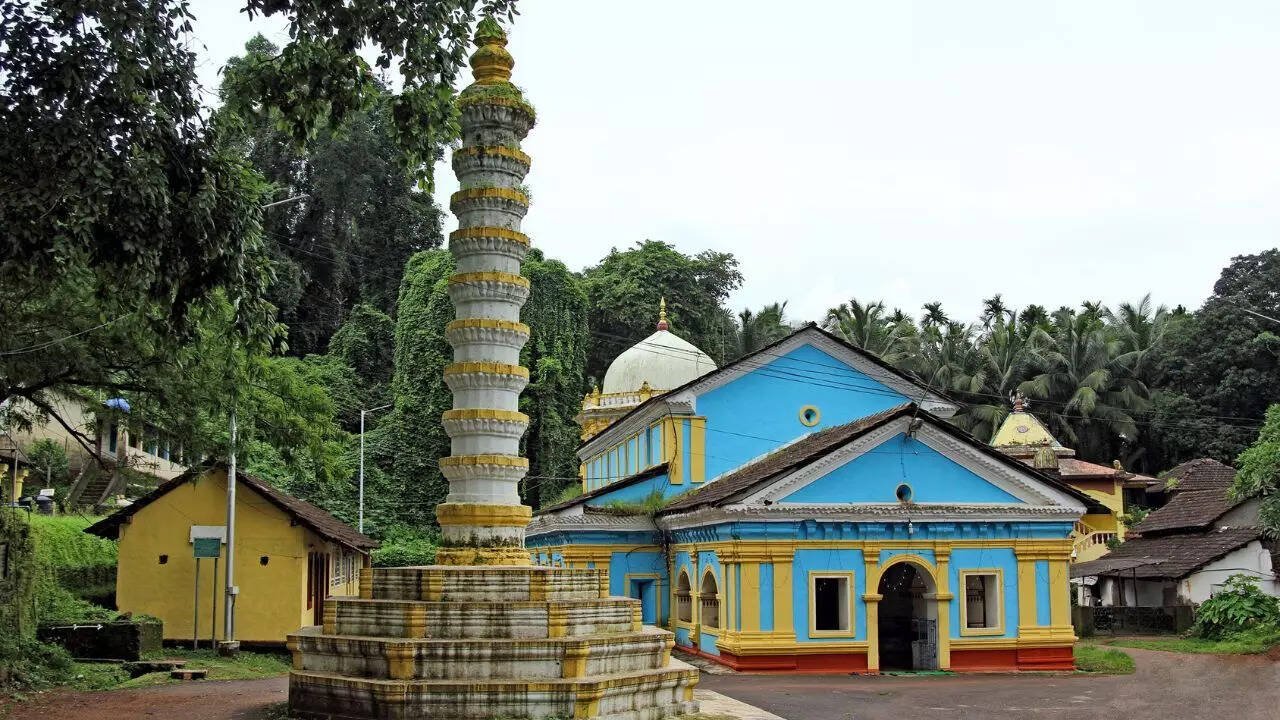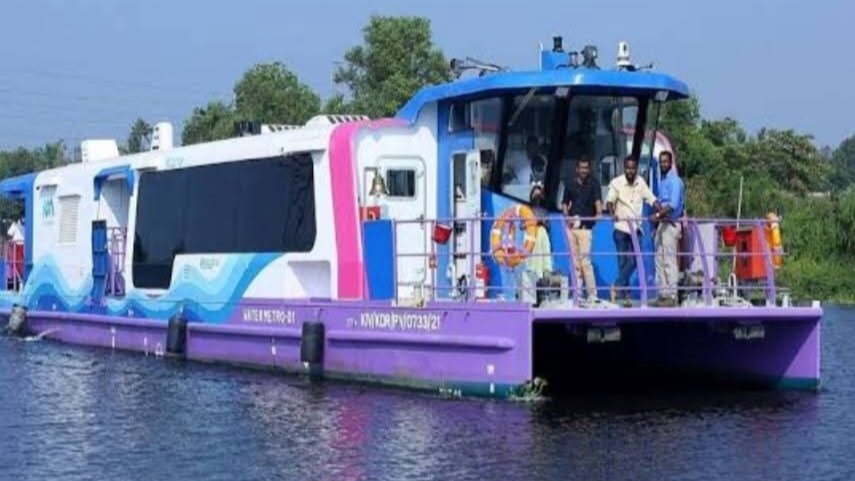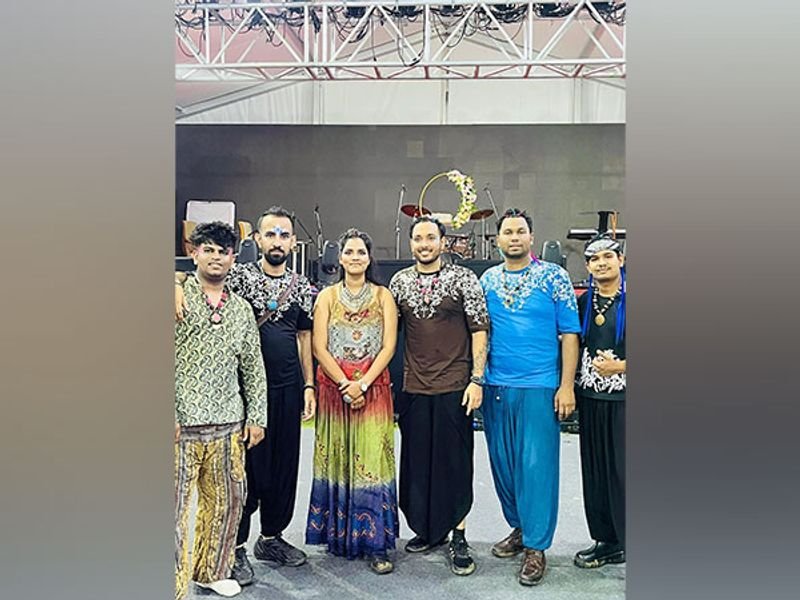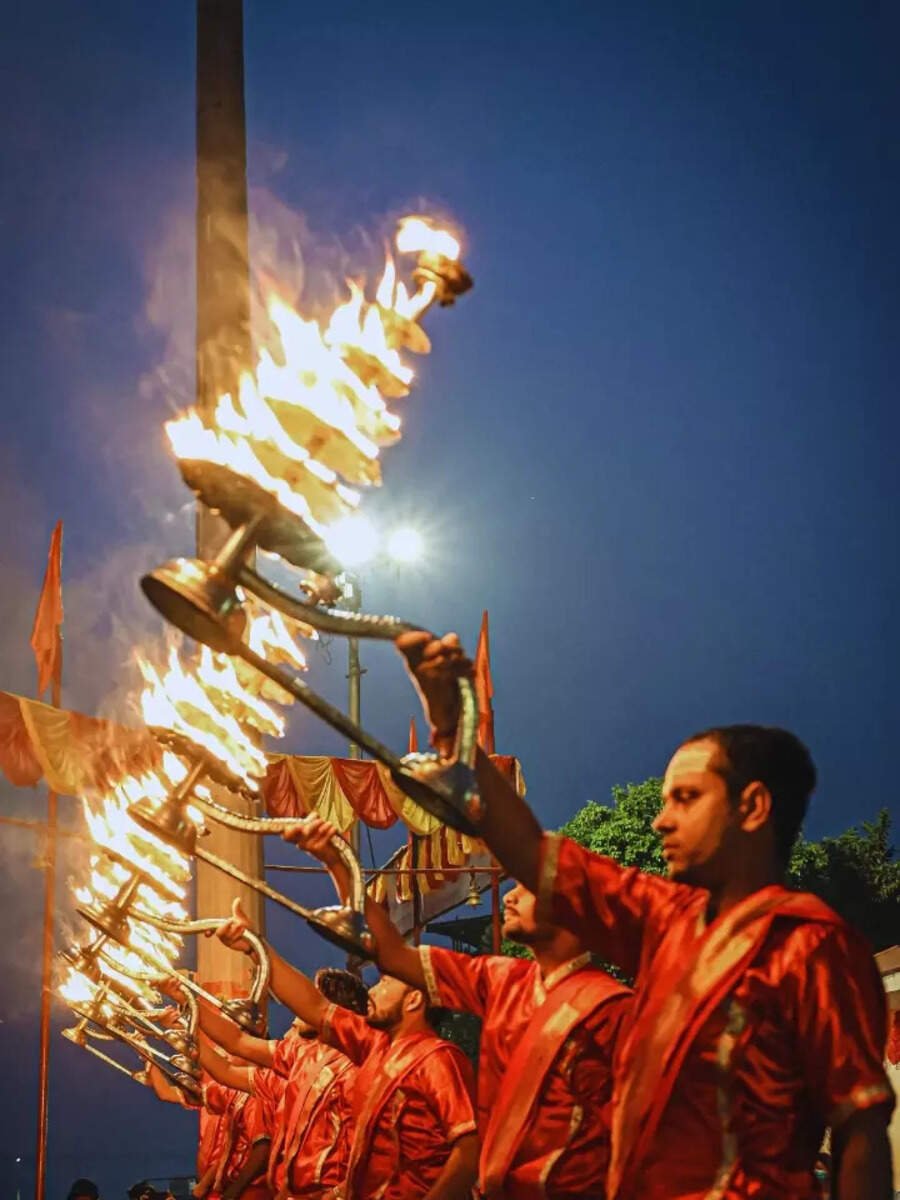Spiritual Travel
Not Just Sand and Surf: There’s More to Goa Than Beaches—Explore Its Hidden Spiritual Wonders!

Saptakoteshwar Temple, Narve (Photo: iStock)
Goa is rightfully famous for its gorgeous beaches, but the state has much more to offer—especially for those seeking spiritual and cultural tourism.
“We are actively working towards enhancing spiritual tourism by preserving heritage sites, improving infrastructure, and creating meaningful cultural engagements,” he stated. “Our goal is to position Goa as a premier spiritual tourism destination while ensuring that we honour and uphold its rich cultural and religious traditions.”
“We have also curated specialised itineraries that cater to different visitor demographics—adventure seekers, beach lovers, and spiritual tourists alike. Collaboration with stakeholders to promote Goa holistically ensures that spiritual tourism adds value rather than competes with its existing tourism strengths.”
One of the key projects under this initiative is the Ekadasha Teertha circuit, which integrates eleven significant temples to offer a fresh perspective on spiritual tourism.
The Ekadasha Teertha circuit is a curated spiritual trail that includes the Shree Mangueshi temple or the Manguesh Devasthan, Mangueshi; Shree Mahalasa Narayani Temple, Mardol; Mahadev Temple, Tambdi Surla; Shee Saptakoteshwar Temple, Narve; Shree Brahma Temple, Sattari; Shree Shantadurga Temple, Fatorpa; Hari Mandir, Margao; Shree Damodar Temple, Zambaulim; Parashuram Temple, Poinguinim; Shree Mahaganapati Temple, Khandola; and Shree Dattatreya Temple, Sanquelim.
Beyond temples, the government is also focused on promoting historic churches and mosques to preserve cultural traditions and highlight Goa’s deep spiritual roots. Khaunte added that improving accessibility and infrastructure around these sites will play a crucial role in attracting visitors.
“To attract both domestic and international visitors, we are enhancing infrastructure around key spiritual sites to ensure better accessibility,” he explained.
Famous Hindu Temples In Goa
Saptakoteshwar Temple, Narve
This Shiva temple dates back to the 12th century and was the deity of the Kings of the Kadamba dynasty. The temple was damaged after the Portuguese conquest in 1540. The Shiva linga was removed for safekeeping and was smuggled away by a local named Narayan Shenvi Suryarao, who took it to a place called Latambarsem, where it remained for three years. In 1543, it was installed in a temple near the island of Divar.
According to the official website of Goa Tourism, “The legend behind the name Saptakoteshwar is also quite interesting. According to the legend, seven holy sages once set out to pray to Lord Shiva near the place where five holy rivers met the sea. They prayed for seven crore years, at the end of which Lord Shiva appeared to grant their wishes and agreed to stay at the place in one of his incarnations. This incarnation is known as Saptakoteshwar (sapt means seven, and koteshwar means lord of crores).”
Shree Mahalasa Temple, Mardol
The Shree Mahalasa Temple is located on the plateau of Verna village in Salcete taluka. It is dedicated to Goddess Mahalasa and finds its reference in the Skanda Purana. Mahalasa is considered the female avatar of Lord Vishnu.
Mallikarjuna Temple, Canacona
Believed to have been constructed in the 6th century, this temple is considered one of the oldest shrines in Goa. It is dedicated to Mallikarjuna, an avatar of Lord Shiva. The temple, with its beautiful wood and silver carvings, is said to have been built by the Habu Brahmins of the Dravidian dynasty.
Shantadurga Temple, Kavlem
One of the most stunning temples in Goa, it is located 33 km from Panaji in Kavlem, Ponda district, North Goa. With a rich history, the current structure was built between 1713 and 1738 AD and houses a mesmerising idol of Goddess Durga.
Spiritual Travel
Bilaspur Set to Transform into Himachal’s Ultimate Adventure and Spiritual Hub

Move over, Manali and Shimla! Bilaspur is gearing up to become the state’s next big tourism hotspot, blending adrenaline-pumping adventures with serene spiritual experiences. The district administration has rolled out ambitious plans to develop water, land, and aerial tourism, promising something for thrill-seekers, pilgrims, and nature lovers alike.
A Sky-High Attraction: The Glass Bridge
Imagine walking on a transparent bridge, suspended high above breathtaking landscapes—Bilaspur’s upcoming Glass Bridge at Bharari will do just that! Designed to rival global attractions, this engineering marvel will offer daredevils an unforgettable experience while giving tourists a reason to extend their stay. Officials confirm the blueprint is ready, and construction will kick off soon after final approvals.
Sailing Through Scenic Routes: The Water Metro
Pilgrims visiting Maa Naina Devi will soon have a faster, more scenic journey thanks to the proposed Water Metro, connecting Bhakra Ghat to Kosariya Ghat. This isn’t just about convenience—it’s about turning travel into an experience. Devotees and tourists can hop on boats, enjoy the tranquil waters, and even transport their vehicles via waterways.
Jet Skis, Kayaking & More: Water Sports at Nakrana
Bhakra Dam’s pristine waters are about to get a lot more exciting! The district is eyeing water sports like jet skiing, kayaking, and boating to attract adventure junkies. The best part? Pilgrims heading to Naina Devi can now add a splash of adventure to their spiritual trip.
Bharari – The New Stopover Destination
Strategically located near Shimla, Manali, and Dharamshala, Bharari will soon feature modern tourist hubs with food plazas, parking, rest areas, and info centers. No more cramped pit stops—just smooth, comfortable breaks for travelers.
Listening to Locals: Boaters Get a Voice
Deputy Commissioner Rahul Kumar made sure local boat operators were heard during inspections, promising quick fixes to their concerns. This people-first approach ensures tourism growth benefits everyone.
Bilaspur’s transformation isn’t just about flashy infrastructure—it’s about jobs for youth, better travel experiences, and putting this hidden gem on India’s tourism radar. With projects set to launch soon, the district is poised to become a must-visit for those seeking adventure, spirituality, and untouched natural beauty.
Spiritual Travel
Shiva Tribe Debuts in Gurgaon’s Tikli-Raiseena: IMPC’s Bold Step to Merge Spirituality, Rural Tourism, and Modern Family Wellness

VMPL
New Delhi [India], August 4: In the lush rural landscape of Tikli-Raiseena near Gurgaon, a new chapter in India’s spiritual and rural tourism ecosystem quietly unfolded. The International Mandir Prabandhak Committee (IMPC) launched its ambitious spiritual wellness initiative–Shiva Tribe–an experience-driven, immersive space designed to reconnect Gen Z and modern families with India’s timeless spiritual roots.
Set against the tranquil backdrop of Haryana’s Aravalli fringes, Shiva Tribe is more than a mandir–it is a curated journey of self-discovery, holistic wellness, and cultural revival, seamlessly merging ancient wisdom with modern aspirations. The inaugural three-day Pran Pratishtha Mahotsav was held in July, graced by spiritual luminaries including Pujya Shri Sudhanshu Ji Maharaj, Pujya Shri Dayanand Ji Maharaj, and dignitaries such as Haryana’s former Minister Shri Om Prakash Dhankar. Business leaders, rural development advocates, and spiritual patrons attended in significant numbers–signaling a rising interest in faith-based tourism models.
Spiritual Tourism: India’s Growing Wellness Sector
India’s spiritual tourism market is undergoing a silent revolution. According to the Ministry of Tourism, the wellness and spiritual tourism segment is projected to reach USD 30 billion by 2028, growing at a CAGR of over 10%. With over 330 million domestic religious tourists recorded annually and rising international interest in authentic Indian experiences, initiatives like Shiva Tribe have the potential to create high-value, low-impact tourism models in rural belts–generating employment, fostering entrepreneurship, and revitalizing local economies.
“In today’s fragmented lifestyle, families are searching for meaningful escapes–not just vacations. Shiva Tribe is that sacred pause–a place to reconnect, reflect, and realign, together,” said Dr. Preet Sandhuu, mentor of the project and a key voice in India’s contemporary spiritual movement.
A New Blueprint: Spirituality Meets Community Living
Unlike traditional spiritual centers, Shiva Tribe offers a complete spiritual-eco retreat–including weekend live devotional music by its in-house ‘Shiva Tribe Band’, yoga sessions, mantra-infused meditations, Vedic rituals, and stay facilities for families. It’s a full-circle experience designed to inspire urban youth and families alike to step into a more conscious, value-driven lifestyle.
“Here, spirituality is not a sermon–it’s an experience,” said Shri MP Singh, project visionary and founder of ShivaTribe. “We want to build a network of such community-driven centers across rural India, using temple heritage as a catalyst for rural rejuvenation and youth engagement.”
Rural Regeneration Through Faith
The Tikli model aligns with India’s rural tourism policy goals by transforming underexplored rural regions into mindful tourism destinations. With over 60% of India’s population residing in villages, initiatives like this leverage India’s spiritual capital to promote rural entrepreneurship, handicrafts, organic farming, and ecotourism–creating a sustainable rural economy rooted in culture and community.
IMPC’s Broader Mission
The International Mandir Prabandhak Committee (IMPC), known for initiatives like the Mahasangam Yatra, Trisul Yatra and Shiv-Shakti Kendras, is rapidly becoming a bridge between India’s ancient temple traditions and its digital future. Its work focuses on temple modernization, spiritual leadership development, and community revival–backed by collaborations with scholars, saints, and civic leaders.
By anchoring the Shiva Tribe initiative in Tikli, IMPC demonstrates how faith-based community models can attract tourism, foster economic inclusion, and support national goals like ‘Viksit Bharat’ and ‘Digital Bharat’.
Shared by
(ADVERTORIAL DISCLAIMER: The above press release has been provided by VMPL. ANI will not be responsible in any way for the content of the same)
(This content is sourced from a syndicated feed and is published as received. The Tribune assumes no responsibility or liability for its accuracy, completeness, or content.)
Spiritual Travel
10 oldest temple towns in India for spiritual getaways – The Times of India

10 oldest temple towns in India for spiritual getaways The Times of India
Source link
-

 Brand Stories2 weeks ago
Brand Stories2 weeks agoBloom Hotels: A Modern Vision of Hospitality Redefining Travel
-

 Brand Stories1 week ago
Brand Stories1 week agoCheQin.ai sets a new standard for hotel booking with its AI capabilities: empowering travellers to bargain, choose the best, and book with clarity.
-

 Destinations & Things To Do2 weeks ago
Destinations & Things To Do2 weeks agoUntouched Destinations: Stunning Hidden Gems You Must Visit
-

 Destinations & Things To Do1 week ago
Destinations & Things To Do1 week agoThis Hidden Beach in India Glows at Night-But Only in One Secret Season
-

 AI in Travel2 weeks ago
AI in Travel2 weeks agoAI Travel Revolution: Must-Have Guide to the Best Experience
-

 Brand Stories1 month ago
Brand Stories1 month agoVoice AI Startup ElevenLabs Plans to Add Hubs Around the World
-

 Brand Stories3 weeks ago
Brand Stories3 weeks agoHow Elon Musk’s rogue Grok chatbot became a cautionary AI tale
-

 Asia Travel Pulse1 month ago
Asia Travel Pulse1 month agoLooking For Adventure In Asia? Here Are 7 Epic Destinations You Need To Experience At Least Once – Zee News
-

 AI in Travel1 month ago
AI in Travel1 month ago‘Will AI take my job?’ A trip to a Beijing fortune-telling bar to see what lies ahead | China
-

 Brand Stories2 weeks ago
Brand Stories2 weeks agoContactless Hospitality: Why Remote Management Technology Is Key to Seamless Guest Experiences


